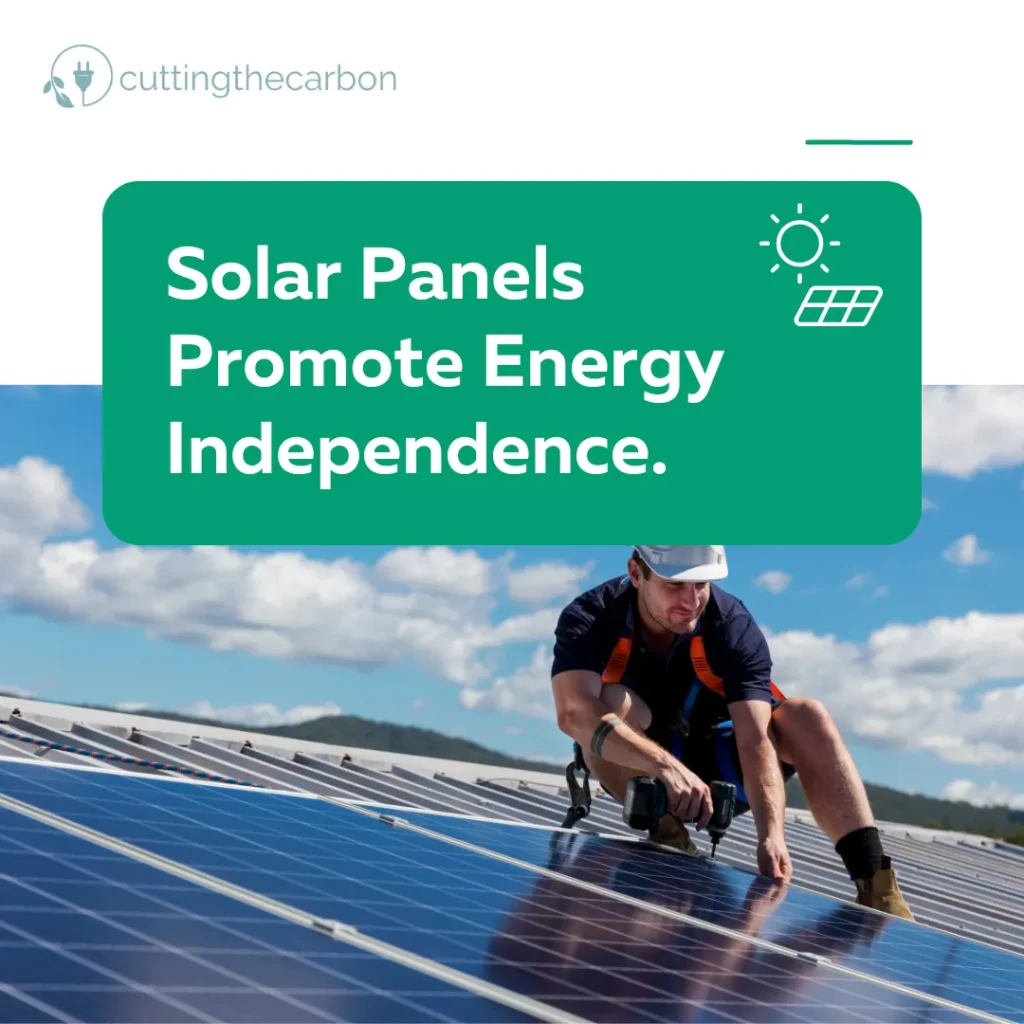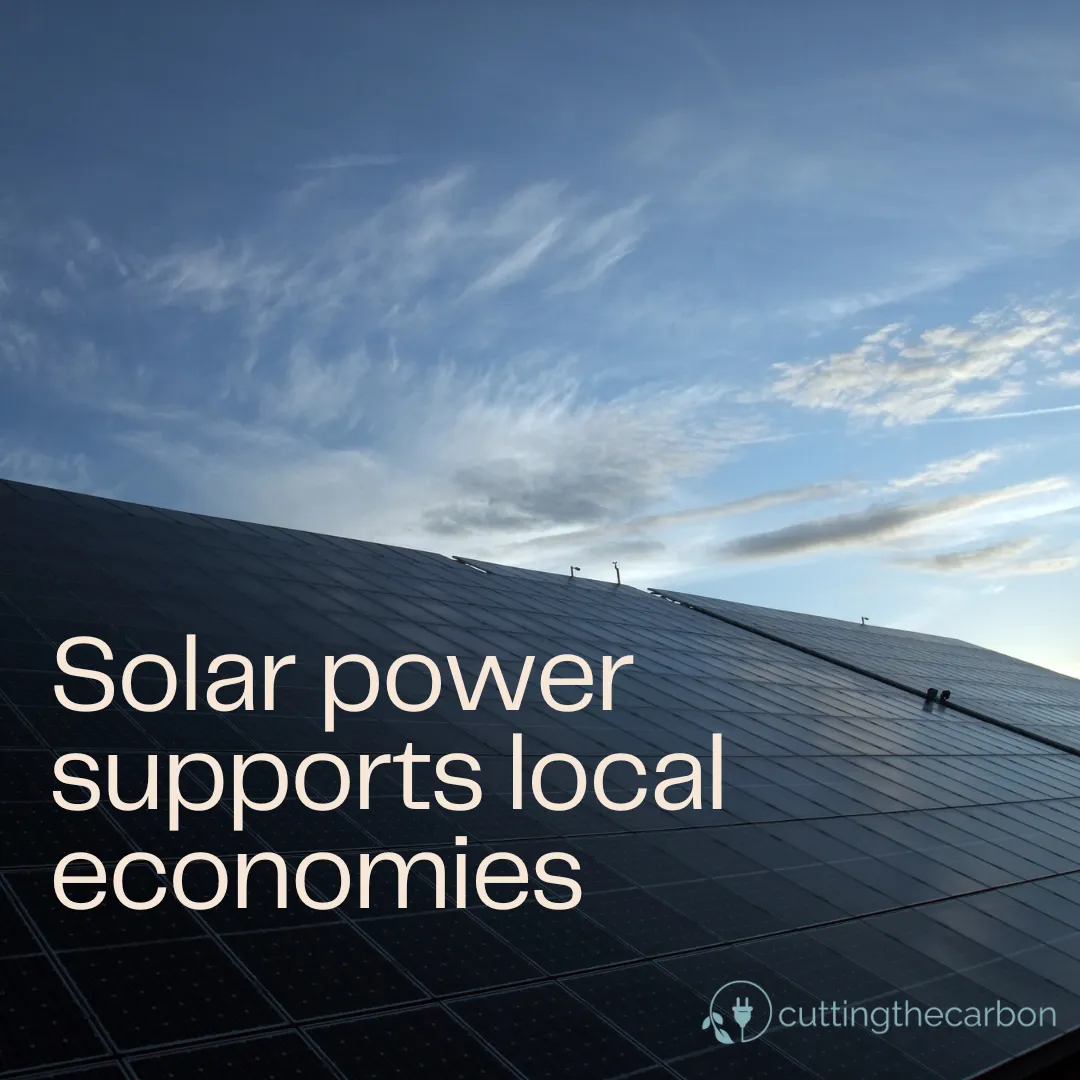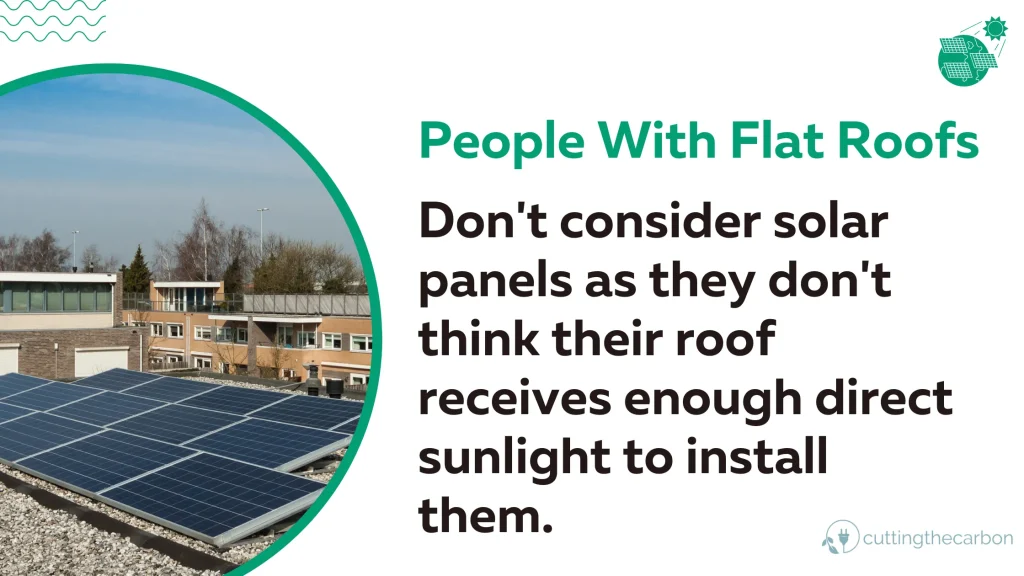Are you considering harnessing the power of the sun to reduce your energy bills and carbon footprint?
Can you put solar panels on a flat roof? – you might ask. Installing solar panels on a flat roof could be the perfect solution for you.
With technological advancements, flat-roof solar panels have become a viable option for domestic and commercial properties, providing numerous benefits and a greener alternative to traditional energy sources.
Join me as we explore the ins and outs of flat roof solar panels in this comprehensive guide.
Short Summary
- Flat roof solar panels offer numerous advantages for domestic and commercial applications, such as cost-effectiveness and easy installation.
- Proper direction, positioning, tilt angle (20-50° facing southwards), maintenance and weatherproofing are essential to ensure the peak performance of flat roof solar panel systems.
- Alternative solutions such as Solar Thermal Systems or Building Integrated Photovoltaics can provide additional energy efficiency benefits with specialized installation & maintenance.
Flat Roof Solar Panels: The Basics
Flat roof solar panels have gained traction recently as a sustainable and cost-effective energy solution. They can be installed on residential and commercial properties, thanks to mounting systems that angle the panels towards the sun for optimal efficiency.
But how do these solar panels work, and what are the different applications for fixing panels for domestic and commercial properties?
Flat roof solar panels are made up of photovoltaic cells that convert sunlight into electricity. This electricity is then used to power appliances and lighting in the home or business. For domestic properties.
How Flat Roof Solar Panels Work
Although solar panels can be installed on various roof types, standing seam metal roofs are considered the most suitable choice due to their ease of installation.
In flat roof systems, solar panels are typically mounted on a framing system that angles the panels towards the sun, ensuring they receive maximum sunlight exposure. This mounting system can either be affixed to the roof or utilize weighted tubs or buckets to support the panels.
However, laying solar panels flat on a roof may limit their ability to absorb sunlight optimally and could result in water damage.
Investing in a mounting system that positions the panels at the optimal angle, typically between 20-50 degrees from the horizontal, is crucial to counter these challenges. This angle not only maximizes sunlight absorption but also facilitates self-cleaning during rainfall.
Here is a table summarising the steps and considerations involved in DIY Solar Panel Installation on a flat roof:
| Step | Description |
|---|---|
| Step 1: Check Weather Conditions | Consider the weather in your area. High winds can be a challenge for flat roof solar installations. |
| Step 3: Choose the Mounting System | Solar panels on flat roofs need to be mounted at a 20-50 degree angle for optimal sunlight absorption. |
| Step 3: Choose The Mounting System | Decide between fixing the panels to the house or adding weight to them. Both methods have their own advantages and considerations. |
| Step 4: Check Planning Permission | Flat roof solar installations may require planning permission. Check with The Planning Portal for England and Wales. |
| Step 5: Consider Costs | Installing solar panels on a flat roof can be more expensive due to the extra cost of materials for the framing system and ballast weight. |
| Step 6: Install Panels | Install the panels using the right mounting equipment. This is crucial for the system’s efficiency. |
A Flat Roof – Solar Installation – 1.6kWp – Step-By-Step Video Guide For UK Homeowners
Domestic vs Commercial Applications
Flat roof solar panel systems are becoming increasingly popular on commercial buildings. They can also offer brilliant energy savings on domestic properties.
Commercial applications generally require more panels and have higher energy demands than domestic applications.
Regardless of the property type, installing solar panels on a flat or roof structure offers numerous advantages, such as cost savings from generating your own electricity, utilizing renewable energy, and benefiting from the government’s feed-in tariff.
Moreover, flat roof solar panels provide an unobtrusive installation, with the panels being less visible from the ground than those on pitched roofs.
This can be particularly appealing for homeowners or businesses looking to maintain their property’s aesthetics while reaping solar energy’s benefits.

Pros and Cons of Flat Roof Solar Panel Installation
As with any investment, weighing the pros and cons of installing solar panels on a flat roof is essential. Some of the key advantages include cost-effectiveness, easy installation, and being less visible.
On the other hand, challenges such as water damage, dirt accumulation, and reduced efficiency due to an incorrect angle need to be considered.
Let’s delve deeper into these pros and cons.
Advantages of Flat Roof Solar Panels
One of the primary benefits of installing solar panels on a flat roof is their cost-effectiveness. Flat roof solar panels are easy to install and require minimal maintenance, contributing to their affordability.
Additionally, the panels can be mounted directly onto the roof, eliminating the need for additional structures and simplifying the installation process.
Another advantage of flat roof solar panels is their inconspicuous nature. The panels can be mounted flush with the roof, reducing visibility from the ground and preserving your property’s aesthetics.
This can be particularly beneficial for those living in urban areas or with strict homeowners’ association regulations.
Challenges and Solutions
Despite the numerous advantages, some challenges are associated with installing solar panels on a flat roof. Some potential drawbacks are water damage, dirt accumulation, and reduced efficiency due to an incorrect angle.
To overcome these challenges, investing in a suitable mounting system is crucial. Mounting systems can support the panels at the optimal angle, ensuring maximum efficiency and minimizing the risk of water damage.
Another challenge is the potential increased weight of the structure, which can pose difficulties in maintenance and require additional bracing and materials.
To address this issue, working with an experienced and reputable solar panel installer who can guarantee proper mounting and maximum efficiency is essential.

Optimal Angle and Positioning for Flat Roof Solar Panels
Achieving the optimal angle and positioning for flat roof solar panels is crucial for their efficiency and longevity. To maximize sunlight absorption and facilitate self-cleaning during rainfall, the top panels on flat roof should be positioned at an angle of 20-50 degrees and face southwards.
Let’s explore the ideal tilt angle and direction for flat roof solar panels.
Ideal Tilt Angle
The recommended tilt angle for flat roof solar panels lies between 20-50 degrees from the horizontal. This range ensures optimal efficiency by maximizing sunlight absorption throughout the day.
The optimal angle for flat roof solar panels in the United Kingdom is 34 degrees. It’s important to note that the ideal tilt angle may vary depending on your geographic location and the specific solar panel system you are using.
Professional solar panel installers use specialized equipment to mount the panels at the proper angle, ensuring maximum efficiency and longevity of the flat roof solar system.
Working with an experienced installer ensures that your flat roof solar panels are positioned correctly and receive as much sunlight as possible, ultimately reducing your energy bills and carbon footprint.
Experience our carbon footprint calculator tool, designed to give a basic, behaviour-oriented estimate of the CO2 emissions one person contributes in a year.
Direction and Orientation
For flat roof solar panels to be most effective, they should be laid flat and facing south. This orientation ensures that the panels receive the maximum amount of sunlight throughout the day, translating into increased energy generation and savings.
Collaborating with a professional solar panel installer who can accurately determine the optimal direction and orientation for your specific system and location is important.

The Implications of Walking on Solar Panels
While it is technically feasible to walk on solar panels, we advise against it due to the inherent safety hazards and the risk of inflicting damage to the panels.
Such damage could not only void the warranty of the solar panels but also significantly degrade their performance and longevity, thereby impacting the overall efficiency of your solar energy system.
It’s crucial to remember that these panels are delicate and designed for capturing sunlight, notwithstanding the weight and movement of people.
Planning, Costs, and Savings
When considering installing solar panels on a flat roof, planning for potential costs and savings is essential. Planning permission may be required in some instances, and installation costs might be higher than on pitched roofs due to additional materials and labour.
However, the potential for significant savings and return on investment makes it worthwhile.
Let’s examine the planning, costs, and savings associated with installing solar panel systems with flat roof solar panels.
Planning Permission Requirements
As mentioned, in some cases, planning permission may be required to install solar panels on a flat roof, particularly in conservation areas or listed buildings.
If the panels protrude more than 0.2 meters above the roof slope, they may contravene the regulations of “permitted development” and require planning permission.
To navigate the planning permissions process, it’s recommended to work with a professional solar panel installer who can provide guidance and assistance.
Additionally, you can find more information on the Planning Portal website, which offers tailored advice and resources for those seeking planning permission for solar panel installations.
Installation Costs and Factors
Installing solar panels on a flat roof can be more expensive than on a pitched roof, with costs ranging from £750 to £900 per kW.
This increased cost is due to the additional materials and labour required for the installation, such as the framing system and ballast weight, as well as the need for a structural engineer.
Despite the higher costs, the long-term savings and environmental benefits make flat roof solar panel installations a sound investment.
If you live in the UK it’s worth noting that Octopus Energy provides solar panel installation options to consider, potentially resulting in an impressive 90% reduction in your electricity expenses.
To minimize the cost of installing solar panels on a flat roof, you can explore solar panel grants or work with an installer who offers competitive pricing. Additionally, investing in a high-quality solar panel system can result in greater savings and a shorter payback period.
Potential Savings and ROI
The potential savings and return on investment from installing solar panels on a flat roof are significant. In the UK, a 3.5 kWp system can result in an annual savings of £608. Over the lifetime of the solar panels, which is typically 25 years, this can amount to a cumulative profit of £7,300.
The break-even point for installing solar panels, where the cost of the solar array is offset by the savings, is approximately 12.9 years. After this point, the savings generated in electricity bills from the solar panels can be considered as profit.
By investing in a flat roof solar panel system, you can not only reduce your energy bills but also contribute to a greener future.
Flat Roof Solar Panel Maintenance and Weather Considerations
Proper maintenance and weatherproofing are crucial for the longevity and efficiency of flat roof solar panels. Ensuring the panels are resistant to wind and weather conditions while also regularly cleaning and maintaining them will keep them operating at peak performance.
Let’s delve into the specifics of weatherproofing and maintenance for flat roof solar panels.
Weatherproofing and Wind Resistance
To ensure the weatherproofing of flat roof solar panels, it’s important to seal the panels and their mounting hardware to prevent water infiltration.
This can help prevent potential water damage and ensure the panels remain efficient throughout their lifespan. In addition, securing the flat solar panels to the house or adding weight to them can protect them from high winds, further increasing their durability and longevity.
Working with a professional solar panel installer can help guarantee that your flat roof solar panels are properly weatherproofed and wind-resistant.
These experts have the knowledge and experience to ensure that your flat roof solar systems and panels are installed and sealed correctly, allowing you to enjoy the benefits of renewable energy without the worry of weather-related damage.
Cleaning and Maintenance Tips
Regular cleaning and maintenance of flat roof solar panels are essential to ensure their optimal performance.
It is recommended to clean solar panels at least every six months to maintain their productivity and efficiency. To clean and maintain flat roof solar panels, use a soft brush, squeegee, and mild detergent, and avoid using abrasive materials or methods that could damage the panels.
In addition to cleaning, it’s important to regularly inspect your solar panels for any signs of damage or wear. This can help you identify and address any potential issues early on, ensuring that your solar panels continue to operate at peak efficiency and generate as much energy as possible.
Alternative Flat Roof Solar Solutions
While solar panels are an excellent option for harnessing renewable energy on flat roofs, alternative solutions are available for those seeking a different approach.
Solar thermal systems and building-integrated photovoltaics (BIPV) offer unique benefits and can be a valuable addition to your green energy arsenal.
Let’s explore these alternative solar installations and flat-roof solar solutions.
Solar Thermal Systems
Solar thermal systems are devices that use the sun’s energy to heat water or air for residential or commercial use.
These systems capture the sun’s energy and convert it into heat, which is then distributed throughout the building.
Solar thermal systems can be highly efficient and provide a viable financial return, making them an attractive option for those seeking to reduce their dependence on traditional energy sources.
There are two types of solar water heating systems: active, which incorporate circulating pumps and controls, and passive, which lack these features. Evacuated tube solar thermal systems are considered the most effective, providing even greater efficiency and savings potential.
Building-Integrated Photovoltaics (BIPV)
Building-integrated photovoltaics (BIPV) are solar panels that are incorporated into the building structure, enabling them to create electricity while also providing insulation and protection from the elements.
BIPV offers several advantages, including increased energy efficiency, improved aesthetics, and reduced installation costs.
BIPV can be more complex to install due to the need for specialized equipment and expertise, but utilizing experienced solar installers and prefabricated components can help overcome these challenges.
With proper installation and maintenance, BIPV systems can offer a long-lasting and visually appealing alternative to traditional solar panels on flat roofs.
Weighing the Solar Panel Factor in UK Housing Market
Can solar panels boost a UK home’s market worth? Absolutely. The shift towards green energy and sustainable living has put properties with solar panels at a premium in the UK, translating into a positive impact on their market value.
Summary
In conclusion, installing solar panels on a flat roof is a viable and cost-effective solution for harnessing the sun’s power to reduce energy bills and carbon footprint.
With proper planning, installation, and maintenance, flat roof solar panels can provide significant savings and contribute to a greener future.
By exploring alternative solutions such as solar thermal systems and building-integrated photovoltaics (BIPV), you can further expand your renewable energy options and make an even greater positive impact on the environment.
Embrace the power of solar energy and take the first step towards a sustainable future today.
Frequently Asked Questions
Can you instal solar panels on a flat roof?
Yes, you can install solar panels on a flat roof. Ballast systems are the most common option as they allow the installation process to be done without the need for any holes.
This makes the installation relatively straightforward, so take advantage of this opportunity and start powering your home with solar energy today.
Do you need a loft for solar panels?
It is generally recommended to fit solar panels on a loft if one is available, as this offers solar panel array the most space and makes them easier to maintain.
Based on the advice of experts, it seems that having a loft is beneficial for fitting solar panels as they will have more space and be easier to access.
Therefore, it may be necessary to have a loft to use solar panels optimally.

